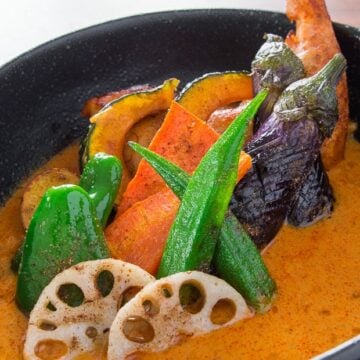Whether it’s the bitter cold, or the historical Russian and Mongolian influences in the region, they do things a little differently up there. The countryside is a patchwork of potato and dairy farms that looks more like a scene from Denmark than what you’d expect from the northernmost island of Japan. I’ve mentioned before that Japanese curry is the de facto national dish of Japan. With its sweet roux-thickened gravy, Japanese curry seems like just the type of dish to take the edge off sub-zero temperatures, and yet determined to buck the trend, Sapporo has come up with its own take on curry. Sapporo Soup Curry (スープカレー) is a light curry flavored soup served with some type of meat, and a rainbow of roasted vegetables. Although it’s a relatively recent concoction, soup curry has blown up over the past decade, with shops specializing in the local dish almost as abundant as shops specializing in another local dish: miso ramen. Despite its popularity, I’ve never been a huge a fan of soup curry. Closer to vegetable soup than a curry, It’s surprising how little spice gets added to most restaurant versions of this dish. Another problem is that the vegetables are cooked independently from the soup, doing neither the veggies nor soup any favors in the flavor department. Still, I love curry from all walks of life, and it was with this resolve that I set out to make a soup curry that tastes as good as it looks. For the chicken I used a technique I learned while making Kabsah (chicken and rice). First I boil the chicken in a 50/50 blend of tomato juice and chicken broth. This not only tenderizes the chicken, it enriches the flavor of the soup. Once the chicken is cooked, I remove it from the liquid, season it, and then roast it until the skin turns golden brown and crisp. This method gives you the best of both worlds, with tender moist chicken, a well browned exterior, and a deeply satisfying broth. For the vegetables, I like to flash fry them, because it caramelizes the sugars, making them sweeter while preserving their vibrant colors. To ensure that they’re just as flavorful as the curry itself, I dust all the fried veggies with a mixture of garam masala and salt. Be warned though, you may want to make some extra as it’s hard to resist snacking on them as you dust them with the fragrant salt. Like a traditional Japanese curry, the sweetness and depth of the soup is largely dependent on how diligently you caramelize the onions, garlic and ginger, which is why it pays to be patient and get them as caramelized as possible. Lastly, to round off the acidity of the tomatoes and give the soup a bit more richness, I like to add coconut milk to the soup at the very end. I used S&B brand curry powder, which is the ubiquitous curry powder in Japan, that gives Japanese curry its distinct taste. If you can’t find it near you, you can also try to make it yourself. As for the vegetables, I used bell peppers, okra, carrots, kabocha pumpkin, lotus root, eggplant and small potatoes in this soup recipe, but any vegetable that will fry well and is colorful will work just fine.
More Japanese Curry
Japanese Curry from Scratch Quick Japanese Curry Curry Udon Curry Fried Rice Japanese Keema Curry Karépan(Japanese Curry Bread)
📖 Recipe







